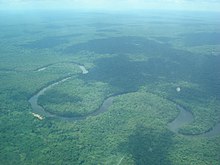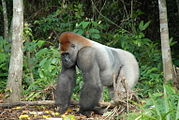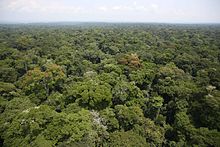Congo Basin
|
Read other articles:

1921 license plates in the United States Vehicle registration plates of the United States by year Vehicle registration plates of the United States for 1920 Events of 1921 Vehicle registration plates of the United States for 1922 Each of the 48 states of the United States of America plus several of its territories and the District of Columbia issued individual passenger license plates for 1921.[1][2][3][4] Passenger baseplates Passenger car pl…

Disambiguazione – Se stai cercando altri omonimi, vedi Ferdinando Gonzaga (disambigua). Questa voce sull'argomento vescovi italiani è solo un abbozzo. Contribuisci a migliorarla secondo le convenzioni di Wikipedia. Segui i suggerimenti del progetto di riferimento. Ferdinando Tiburzio Gonzagavescovo della Chiesa cattolica Incarichi ricopertiVescovo di Mantova (1671-1672) Nato14 aprile 1611 a Vescovato Ordinato presbitero28 dicembre 1639 Nominato vescovo23 febbraio 1671 da papa…
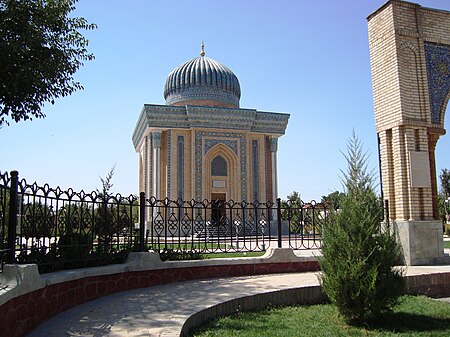
Indian Islamic scholar (1826–1905) Maulana Rashid Ahmed GangohiPersonalBorn1826[1][2]Gangoh, Ceded and Conquered Provinces, British India[1]Died11 August 1905 (aged 78)[1][2]Gangoh, United Provinces, British IndiaReligionIslamNationalityIndianDenominationSunniJurisprudenceHanafiCreedMaturidiMovementDeobandiMain interest(s)Aqidah, Tafsir, Hadith, FiqhNotable idea(s)Darul Uloom DeobandMilitary serviceYears of service1857Battles/warsIndian War of Independen…

Stasiun Kambangan Kambangan+76 m LokasiLamongrejo, Ngimbang, Lamongan, Jawa TimurIndonesiaKoordinat8°12′51″S 114°22′48″E / 8.21417°S 114.38000°E / -8.21417; 114.38000Koordinat: 8°12′51″S 114°22′48″E / 8.21417°S 114.38000°E / -8.21417; 114.38000Ketinggian+76 mOperator Kereta Api IndonesiaDaerah Operasi VII Madiun Letakkm 29+475 lintas Jombang–Ploso–Babat[1] Layanan-KonstruksiJenis strukturAtas tanahInformasi lainK…

豪栄道 豪太郎 場所入りする豪栄道基礎情報四股名 澤井 豪太郎→豪栄道 豪太郎本名 澤井 豪太郎愛称 ゴウタロウ、豪ちゃん、GAD[1][2]生年月日 (1986-04-06) 1986年4月6日(38歳)出身 大阪府寝屋川市身長 183cm体重 160kgBMI 47.26所属部屋 境川部屋得意技 右四つ・出し投げ・切り返し・外掛け・首投げ・右下手投げ成績現在の番付 引退最高位 東大関生涯戦歴 696勝493敗66�…

Artikel ini perlu diwikifikasi agar memenuhi standar kualitas Wikipedia. Anda dapat memberikan bantuan berupa penambahan pranala dalam, atau dengan merapikan tata letak dari artikel ini. Untuk keterangan lebih lanjut, klik [tampil] di bagian kanan. Mengganti markah HTML dengan markah wiki bila dimungkinkan. Tambahkan pranala wiki. Bila dirasa perlu, buatlah pautan ke artikel wiki lainnya dengan cara menambahkan [[ dan ]] pada kata yang bersangkutan (lihat WP:LINK untuk keterangan lebih lanjut). …

Painting by Circle of Tintoretto Christ at the Sea of GalileeArtistJacopo TintorettoYear1570sMediumOil on canvasDimensions117.1 cm × 169.2 cm (46.1 in × 66.6 in)LocationNational Gallery of Art, Washington, D.C. Christ at the Sea of Galilee is an oil painting by Jacopo Tintoretto. The painting depicts Jesus Christ raises a hand toward the apostles, who appear in a boat amid hostile waves at sea. It is an example of mannerism,[1] a European art s…
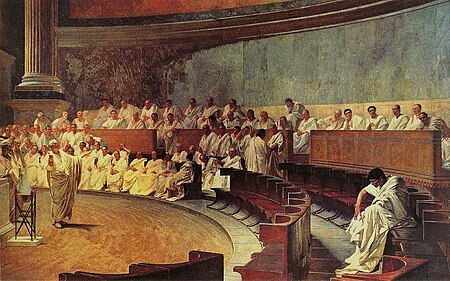
Method of interpreting texts Mimesis criticism is a method of interpreting texts in relation to their literary or cultural models. Mimesis, or imitation (imitatio), was a widely used rhetorical tool in antiquity up until the 18th century's romantic emphasis on originality. Mimesis criticism looks to identify intertextual relationships between two texts that go beyond simple echoes, allusions, citations, or redactions. The effects of imitation are usually manifested in the later text by means of …

Olga DanilovićDanilović, 2022NamaОлга ДаниловићOlga DanilovićKebangsaan SerbiaTempat tinggalBelgrade, SerbiaLahir23 Januari 2001 (umur 23)Belgrade, FR Yugoslavia (sekarang Serbia)Tinggi182 m (597 ft 1 in)Tipe pemainLeft-handed (two-handed backhand)PelatihRobert CokanTotal hadiahUS$ 871,444TunggalRekor (M–K)132–79 (62.56%)Gelar1Peringkat tertinggiNo. 96 (8 Oktober 2018)Peringkat saat iniNo. 157 (12 September 2022)Hasil terbaik di Grand Slam (tunggal)Au…

Methods of delivering voice communications and multimedia over IP networks Voice over Internet Protocol (VoIP[a]), also called IP telephony, is a method and group of technologies for voice calls for the delivery of voice communication sessions over Internet Protocol (IP) networks,[2] such as the Internet. The broader terms Internet telephony, broadband telephony, and broadband phone service specifically refer to the provisioning of voice and other communications services (fax, SM…
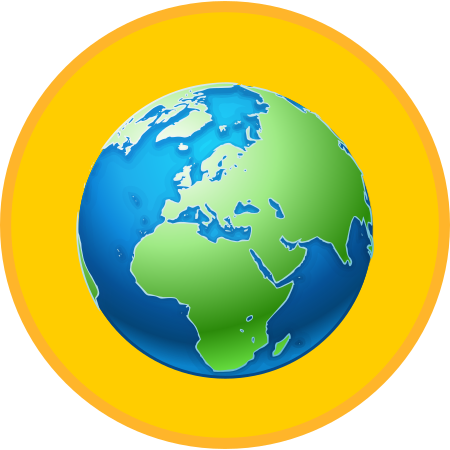
Canada national softball teamInformationCountryCanadaFederationSoftball CanadaConfederationWBSC AmericasManagerJohn StuartWBSC World Rank 4 2 (26 April 2023)[1]Men's Softball World ChampionshipAppearances17 (First in 1966)Best result Gold (4: 1972, 1976, 1992, 2015) The Canada men's national softball team represents Canada in international softball. They are overseen by Softball Canada, the governing body of softball in Canada. Competitive record The Canada men's national softball team p…

Album PerdanaAlbum studio karya Jimmie ManopoDirilis1980GenrePopLabelAkurama RecordsKronologi Jimmie Manopo Album Perdana (1980) Ceritamu Ceritaku (1983)Ceritamu Ceritaku1983 Album Perdana merupakan album musik utama karya Jimmie Manopo. Dirilis pada tahun 1980. Lagu utamanya di album ini ialah Ratih Puspa. Daftar lagu Ratih Puspa Selembut Mega (ft. Bamboe's Girls) Purnama Prambanan Tantangan Jalinan Kasih (ft. Bamboe's Girls) Cinta Merdeka Dewi Rembulan Adakah Hari Ini Setulus Janji Mentari…

العلاقات الإستونية السيشلية إستونيا سيشل إستونيا سيشل تعديل مصدري - تعديل العلاقات الإستونية السيشلية هي العلاقات الثنائية التي تجمع بين إستونيا وسيشل.[1][2][3][4][5] مقارنة بين البلدين هذه مقارنة عامة ومرجعية للدولتين: وجه المقارنة إستوني�…

李佳女艺人英文名Miranda Lee出生 (1978-07-03) 1978年7月3日(45歲) 中国上海职业歌手语言粵語、英語、國語音乐类型流行音樂经纪公司無綫電視(2023年至今)[1]网站mirandalee78.com 李佳(英語:Miranda Lee Jia,1978年7月3日—),香港女歌手,是2022年香港無綫電視歌唱選秀節目《中年好聲音》亞軍[2]。2023年簽約香港無綫電視[1]。 簡歷 此章節尚無參考來源,內容或�…

Questa voce o sezione sugli argomenti fontane e Francia non cita le fonti necessarie o quelle presenti sono insufficienti. Puoi migliorare questa voce aggiungendo citazioni da fonti attendibili secondo le linee guida sull'uso delle fonti. Fontana dei Medici La fontana de' Medici (in francese fontaine Médicis) è una fontana di Parigi, situata nei giardini del Lussemburgo nel VI arrondissement. La fontana deve il suo nome a Maria de' Medici che la commissionò a un ignoto architetto per dec…

Commuter rail station in Chicago, Illinois This article needs additional citations for verification. Please help improve this article by adding citations to reliable sources. Unsourced material may be challenged and removed.Find sources: 91st Street–Beverly Hills station – news · newspapers · books · scholar · JSTOR (November 2015) (Learn how and when to remove this message) 91st Street–Beverly Hills91st Street–Beverly Hills station in October …

Public park in Manhattan, New York Damrosch ParkLocationAmsterdam Avenue and West 62nd Street, Manhattan, New YorkCoordinates40°46′19″N 73°59′05″W / 40.7720°N 73.9846°W / 40.7720; -73.9846Area2.4 acres (0.97 ha)Established1969Administered byCity of New York Parks and RecreationWebsiteOfficial website Buildings of Lincoln Center 100m110yds 13 12 11 10 9 8 7 6 5 4 3 2 1 viewtalkeditBuildings and structures in Lincoln Center:1 Samuel B. and David R…

This article relies largely or entirely on a single source. Relevant discussion may be found on the talk page. Please help improve this article by introducing citations to additional sources.Find sources: EA-2054 – news · newspapers · books · scholar · JSTOR (September 2018) EA-2054 Names Preferred IUPAC name N,N,N-Trimethyl-3-({[(propan-2-yl)oxy](methylphosphonoyl)}oxy)-5-{3-[3-(trimethylazaniumyl)phenoxy]propoxy}anilinium bis(tetraphenylboranuide) Ident…

New Zealand-born economist Allan George Barnard FisherBorn26 February 1895 (1895-02-26)Christchurch, New ZealandDied8 June 1976(1976-06-08) (aged 81)London, EnglandScientific careerFieldsEconomics Economic sectors Three-sector model Primary sector (raw materials) Secondary sector (manufacturing) Tertiary sector (services) Additional sectors Quaternary sector (information services) Quinary sector (human services) Theorists AGB Fisher Colin Clark Jean Fourastié Sectors by ownership Busi…

Ilustrasi formasi ala catenaccio Catenaccio adalah sistem taktis dalam permainan sepak bola yang menitikberatkan kekuatan pada pertahanan.[1] Dalam bahasa Italia, catenaccio berarti Kunci sehingga dapat diartikan bahwa catenaccio adalah strategi permainan dengan pertahanan yang terorganisir dan efektif agar lawan kesulitan menyerang atau mencetak gol.[1] Strategi ini dikenal luas ketika pada tahun 1960-an Helenio Herrera menerapkannya pada Internazionale.[1] Ciri khusus d…




